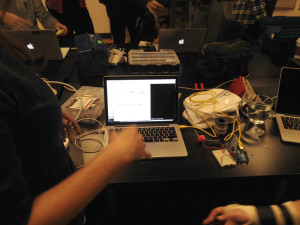ICM, Wk 4.5: Synthesis Lab
Almost forgot! The Synthesis Lab!
On the whole, I enjoyed the synthesis lab last Friday. I liked the fun-spirited nature of what had previously seemed a quite-daunting task: connecting our arduinos to communciate with p5.js. In PComp last Thursday, Benedetta was very wary of how it would all go, given that p5.js is still very new and there were some things still to be worked out.
Given the “Design Challenge” nature of the lab, particularly the one hour time constraint – there wasn’t much thought given to the idiosyncrasies of p5. It was hard to tell if a problem came from our code or from something else and TBH, me and my partner got to the actual serial communication aspect of our project on the later side.
Quick summarization of our idea: We wanted to make a virtual slot machine, where when you pressed a button a combination of images would appear with a related short poem. We had a couple different inspirations, one being a project I did with my art collective in Baltimore: “Baltimore, Take Your Chances”. When we did this project, we tried to hook up a button to manipulate the slot machine, but ended up faking it instead. I wanted to see if we could actually do something like that.
While we were discussing what exactly would emerge form the slot machine, Renata had the idea of Haikus and showed me the work of Rafael Rozendaal. We liked his poems about everyday experiences and objects and thought we could do an interpretation using items from around ITP.
In terms of the coding, we created three arrays of images for the slot machine and three arrays of text for the corresponding poems. What we wanted to happen was that the images would appear like they were spinning/randomizing, then settle on an image and whatever text corresponded would appear below, with randomized verbs and prepositions interspersed to give form and coherence to the sentence.
We got as far as creating our arrays and having them alternate between three different possibilities.
Then we tried to add in a switch to alternate between the states – but realized on the late end that because of the way that our code was written and using a digital input, we could only switch between and “OFF” and an “ON” state, and that whenever it went to the “ON” state, it would only show the first possibility, since when it would turn off it would reset. People who looked at the project later mentioned we could try using analog input or a bounce() function.
Still, pretty happy with what we came up with in about an hour’s time. Would definitely be interested in expanding it more at a later date.
Check out Renata’s post to hear more!
